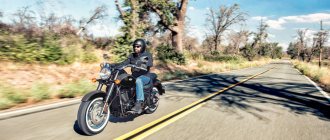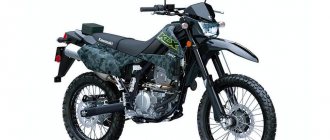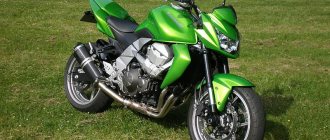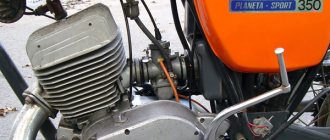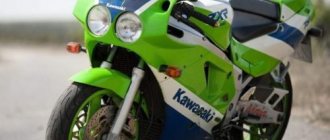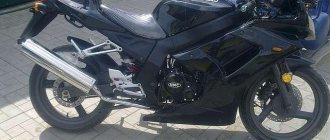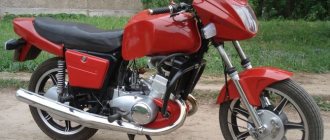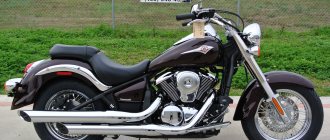| Kawasaki ZXR750 / ZX-7 (ZX750H), 1989-1990 | Kawasaki ZXR750 / ZX-7 (ZX750J), 1991-1992 | Kawasaki ZXR750 / ZX-7 (ZX750L), 1993-1995 |
| Kawasaki ZXR750R / ZX-7R (ZX750K), 1991-1992 | Kawasaki ZXR750R / ZX-7R (ZX750M), 1993-1994 |
Kawasaki ZXR750 sports motorcycle model
appeared in 1989 as the successor to the Kawasaki GPX750R and one of the main competitors to the Suzuki GSX-R750. The concept of Japanese sports motorcycles with an engine capacity of 750 cc was quite interesting: companies were trying to create a mid-range model, between 600 cc and 1000 cc, that had the advantages of both (light weight, handling) and the other (power). The Kawasaki ZXR750 is a prominent representative of such attempts.
The Kawasaki ZXR 750 model was aimed not only at the Japanese market, but was also actively sold in Europe and North America. Moreover, it is worth canceling that foreign markets were the main priority for sales. Japanese versions were produced with an engine of limited power up to 77 hp. (export full-power versions produced up to 128 hp; a power increase package of up to 145 hp was also available on models of recent years of production), which sharply reduced demand. In the North American market, the ZXR750 was sold under the name Kawasaki ZX-7 (ZX-7R)
.
Features of the Kawasaki ZXR 750 include an aluminum frame, an inertial charging system (since 1993), adjustable sports suspension, powerful 4-piston brakes, a 6-speed gearbox, an 18-liter fuel tank and a dry weight of 195 kg.
Main modifications of the Kawasaki ZXR 750:
- Kawasaki ZXR750 / Ninja ZX-7
is the regular version of the motorcycle. Has a passenger seat. Designated as: ZX750H, ZX750J, ZX750L. - Kawasaki ZXR750R / Ninja ZX-7R
- “track” version of the motorcycle. Was available from 1991 to 1994. It has a plug in place of the passenger seat, a 17-liter aluminum fuel tank (since 1993), flat-throttle carburetors, slightly increased engine power, fully adjustable suspension (with the ability to change height) and other gearbox settings.
1995 was the last year of production of the model, after which it came off the production line and was replaced by the Kawasaki ZX-7R / ZX-7RR. Currently, the ZXR750 model is quite rare both in Russia and at Japanese auctions, enjoying limited demand.
Kawasaki ZXR series lineup:
- Kawasaki ZXR250
- Kawasaki ZXR400
- Kawasaki ZXR 750
The main competitors of the Kawasaki ZXR 750 in the class:
- Yamaha FZR 750
- Yamaha YZF 750
- Suzuki GSX-R 750
- Honda CBR750/Honda VFR750R
Brief history of the model
- 1989 – start of production and sales of the Kawasaki ZXR750 (Ninja ZX-7 in North America).
Model
: Kawasaki ZXR750 / Ninja ZX-7 (Japan, Europe, North America).
Factory designation
: ZX750-H1.
- 1990 - the model receives new carburetors, minor changes to the rear suspension, engine and cylinder head, as well as an enlarged radiator. A 14 amp-hour battery is replaced with a 12 amp-hour battery.
Model
: Kawasaki ZXR750 / Ninja ZX-7 (Japan, Europe, North America).
Factory designation
: ZX750-H2.
- 1991 - restyling of the model. The bike gets a new die-cast frame, inverted forks and a new engine. The appearance of a “track” modification - Kawasaki ZXR750R (Ninja ZX-7R - in North America).
Model
: Kawasaki ZXR750 / Ninja ZX-7;
Kawasaki ZXR750R / Ninja ZX-7R (Japan, Europe, North America). Factory designation
: ZX750-J1; ZX750-K1.
- 1992 - no significant changes.
Model
: Kawasaki ZXR750 / Ninja ZX-7;
Kawasaki ZXR750R / Ninja ZX-7R (Japan, Europe, North America). Factory designation
: ZX750-J2; ZX750-K2.
- 1993 - restyling of the model. The motorcycle is equipped with an inertial supercharging system (Ram-Air). The regular version of the motorcycle receives the engine from the “track” modification of the previous generation (ZX750K), but with a standard gearbox.
Model
: Kawasaki ZXR750 / Ninja ZX-7;
Kawasaki ZXR750R / Ninja ZX-7R (Japan, Europe, North America). Factory designation
: ZX750-L1; ZX750-M1.
- 1994 is the last year of production of the “track” modification.
Model
: Kawasaki ZXR750 / Ninja ZX-7;
Kawasaki ZXR750R / Ninja ZX-7R (Japan, Europe, North America). Factory designation
: ZX750-L2; ZX750-M2.
- 1995 is the final year of production of the model.
Model
: Kawasaki ZXR750 / Ninja ZX-7 (Japan, Europe, North America).
Factory designation
: ZX750-L3.
Additional design features
- The new instrument panel allows the driver to instantly read current information. The analog tachometer is complemented by a liquid crystal display, which displays the speedometer, odometer, distance traveled per day, water temperature sensor, fuel level indicator, clock, etc. Reducing the time it takes to read information from devices allows the motorcyclist to better concentrate on the road.
- The ignition switch of most models supplied to Europe has an immobilizer function, which helps prevent the theft of the motorcycle.
Specifications
Technical characteristics of Kawasaki ZXR 750:
| Model | Kawasaki ZXR750 |
| Motorcycle type | sports |
| Year of issue | 1989-1995 |
| Frame | aluminum diagonal |
| engine's type | 4-cylinder, 4-stroke, in-line |
| Working volume | 749 cm³ |
| Bore/Stroke | 68.0 x 51.5 mm – ZX750H 71.0 x 47.3 mm – ZX750J-M |
| Compression ratio | 11.3:1 |
| Cooling | liquid |
| Number of valves per cylinder | DOHC, 4 valves per cylinder |
| Fuel supply system | Carburetor, 4x Keihin CVKD36 – ZX750-H1 Carburetor, 4x Keihin CVKD38 – ZX750-H2, ZX750J, ZX750L Carburetor, 4x Keihin FVKD39 (flat throttle) – ZX750K, ZX750M |
| Ignition type | transistor |
| Maximum power | 77.0 hp (56.6 kW) at 9000 rpm – ZXR750 (Japanese versions) 118.0 hp (87.0 kW) – ZX750H – full power versions 122.0 hp (90.0 kW) – ZX750J-K – full power versions 128.0 hp (94.0 kW) – ZX750L-M – full power versions |
| Maximum torque | 66.0 Nm (6.7 kg*m) at 6500 rpm – ZX750-H1 (Japanese versions) 67.0 Nm (6.8 kg*m) at 7000 rpm – ZX750-H2 (Japanese versions) 68.0 Nm (6.9 kg*m) at 6500 rpm – ZX750J-M (Japanese versions) 68.0 Nm (6.9 kg*m) at 7000 rpm – ZXR750R (Japanese versions) 77.0 Nm (7.8 kg*m) at 10,000 rpm - full power versions |
| Clutch | Multi-disc in oil bath, hydraulic drive |
| Transmission | 6-speed |
| type of drive | chain |
| Front tire size | 120/70 ZR17 |
| Rear tire size | 170/60 VR17 – ZX750-H1 180/55 ZR17 – ZX750-H2-M |
| Front brakes | 2 discs, 320 mm, 4-piston calipers |
| Rear brakes | 1 disc, 230 mm, 2-piston caliper |
| Front suspension | Telescopic fork (adjustable), 120 mm travel – ZX750H Inverted fork (adjustable), 120 mm travel – ZX750J-M |
| Rear suspension | Uni-Trak swingarm with monoshock (adjustable), 140 mm travel – ZX750H Uni-Trak swingarm with monoshock (adjustable), travel – 135 mm – ZX750J-M |
| Motorcycle length | 2090 mm – ZX750H 2085 mm – ZX750J-M |
| Motorcycle width | 755 mm – ZX750H 730 mm – ZX750J-M |
| Motorcycle height | 1170 mm – ZX750H 1120 mm – ZX750J-K 1140 mm – ZX750L-M (North American version) 1125 mm – ZX750L-M (European version) |
| Wheelbase | 1455 mm – ZX750H 1420 mm – ZX750J-K 1430 mm – ZX750L-M |
| Seat height | 770 mm – ZX750H 780 mm – ZX750J-K 800 mm – ZX750L-M |
| Minimum ground clearance | 110 mm – ZX750H-K 100 m – ZX750L-M |
| Acceleration 0-100 km/h (0-60 mph) | 3.4 sec. |
| Maximum speed | 245 km/h |
| Gas tank capacity | 18.0 l – ZX750H-L 17.0 l – ZX750M |
| Motorcycle weight (dry) | 205 kg – ZX750-H1, ZX750L 200 kg – ZX750-H2, ZX750M 195 kg – ZX750J-K |
Kawasaki Z750: The Serious Street Fighter's Honed Tool
The new Z750 combines excellent city driving performance with aggressive styling. Designed specifically for extreme street racing, this new generation streetfighter has a perfectly balanced engine and chassis. The wide, generous powerband delivers killer acceleration with a smooth, long torque curve, while the flexible chassis delivers quick, easy cornering with excellent stability. The Z750 's suspension settings and tires are designed to provide responsive performance on a variety of road surfaces and riding conditions. In fact, it is this complex of superbly balanced ride quality that is the most noticeable characteristic of the Z750.
.
With superior power and ease of handling, as well as exceptional looks, the new Z750
may be the most well-designed vehicle of the new model year.
(Picture shows ABS model)
A perfectly balanced representative of the Z series
The main goal when developing the new “Z” series was “the embodiment of a real streetfighter.” Although both the new Z1000 and the new Z750 fit this concept, they were created using fundamentally different approaches. Where the Z1000 explodes with enormous power and unabashedly demonstrates its performance, the Z750 behaves more refined, revealing a clear and rapid rise in revs and sharp handling with excellent driver feedback. “Perfect balance” is a phrase that most accurately applies to the new Z750 . With avant-garde styling that perfectly accentuates the performance of this street fighter's polished weapon, the Z750 truly carves a path into the future.
Refined handling
The Z750 maintains excellent handling in a variety of driving situations, including city streets, highways and switchbacks. The flexible and compact chassis gives the Z750 excellent agility and precise handling. The chassis characteristics have been improved by moving the steering column and using a new inverted fork with a 41 mm diameter of stays. Compared to the previously used conventional fork, the new version is designed to cope with the heavier loads of sport riding and seriously improves the handling and feel of the motorcycle.
Responsive chassis
The updated chassis provides the rider with excellent feedback. The chassis rigidity is perfectly balanced to provide high responsiveness throughout the entire speed range. Moreover, the improved positioning of the saddle, handlebars and footpegs also contributes to improved contact between the rider and the motorcycle. New Z750
gives the rider a confidence-inspiring feeling of complete control, perfectly complementing the motorcycle's precise and sharp handling.
Sensible power
In addition to the chassis upgrades, the Z750's powertrain has been redesigned. The 748cc, 16-valve, inline-four, liquid-cooled engine delivers even greater acceleration and unrivaled power for today's urban racer. Redesigned intake ports, new cam profiles and other changes to the intake system provide smoother mid-range torque characteristics. Along with improvements to mid-range power, the new Z750's rev-driven acceleration delivers the kind of adrenaline rush that was only possible at high rpm in the previous model. Kawasaki's no-compromise approach to performance greatly enhances the Z750's ride quality. The amazing efficiency and improved performance of the redesigned engine underpin the sportier character of the new Z750. Improved power performance is accentuated by a new, unique dual-exhaust muffler that delivers the typical sound of a true Kawasaki .
In short, the new Z750 is a perfectly balanced motorcycle, ready to unleash its full potential to meet the expectations of true street racers.
Reviews
Reviews about Kawasaki ZXR750:
Expand Collapse
You need to ride it with a sober head (in every sense of the word) and without a sense of fear. Believe me, it gets in the way when you're driving under two hundred. Anyone who thinks that it is better to ride at a maximum of 100-120 km per hour should not buy a sports bike. Less than 3 seconds to 100 km/h, the acceleration is such that the bike is trying to rear up and you feel how difficult it is for your head to keep up with the acceleration of your body. Bottom line, all this is interesting, but I won’t get on a bike again without a protective suit; it’s not worth playing “cat and mouse” with fate once again.
A very good device. For those who have grown from 400k, but do not want to take a heavy, power-hungry liter. It gets up from the gas to the wheel without any problems.
What do the owners say?
Judging by the reviews from photos and videos, the car performs well on smooth roads. However, on problem sections of the route it is important to drive slowly. This applies to all sportbikes with classic suspension travel. The point is not only about the safety of the driver and others, but also about the fact that potholes quickly cause this and other representatives of the class to become unusable.
Most of the controversy concerns urban conditions. However, it is important to note that these, again, do not directly relate to the Kawasaki ZXR 750. We are talking about the sport class and whether it is advisable to buy such an option for an urban environment, no matter how much you like the characteristic design, fit and sounds.
According to the description of those who often travel around the city, the motorcycle often falls over in a smoothly flowing traffic jam. However, compared to sports tourists, the problem is not so acute. The view through the windshield suits everyone, as does driving on country roads.
Most owners are sympathetic to the technical characteristics of this sportbike, but warn that spare parts are not so easy to obtain, which makes maintenance difficult. Nowadays it’s no longer possible to get a new motorcycle, but the cost of a used one is low, and many people note this. About 190 thousand Russian rubles - that’s how much such a car costs.
Kawasaki ZXR 750 is a good bike for its era. Now the model is suitable for those who do not want to drive a super-powerful representative of the sports class. If average speeds suit you, then this option will please you on the race track. For those who need a regular bike to get around, neither this machine nor any other sports bike is suitable.


